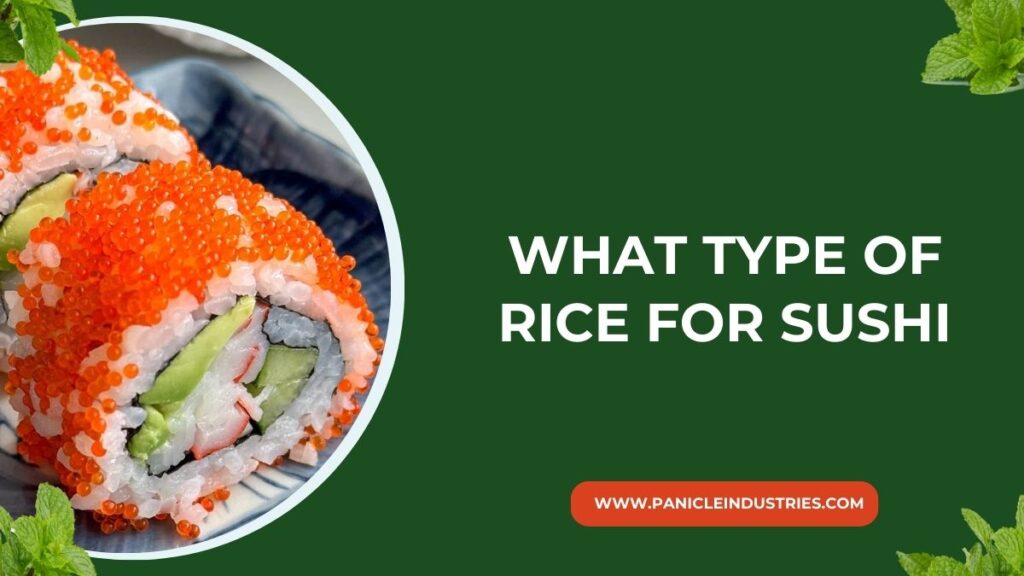If you’re new to making sushi at home, one of the first questions that may come to your mind is what type of rice for sushi is the right one. You may think any rice will do, but that’s not true. Sushi rice is different from regular rice in both texture and taste. Using the right rice can make your sushi delicious and hold together perfectly. On the other hand, using the wrong rice can make it fall apart or taste off.
In this blog, we will explain everything you need to know in very simple words so you can pick the right rice and enjoy making sushi the right way.
Why Rice Is So Important in Sushi
When people think of sushi, they often picture fish, seaweed, or soy sauce. But the truth is, rice is the heart of sushi. The word “sushi” actually means “sour rice” in Japanese. This is because sushi rice is seasoned with a mix of vinegar, sugar, and salt.
The rice needs to be sticky enough to hold the sushi shape, but not too mushy or dry. That balance comes from using the right kind of rice and cooking it the correct way. So before anything else, choosing the correct rice is your first step to making great sushi at home.
Also read: What Type of Rice for Risotto?
What Type of Rice for Sushi?
The best type of rice for sushi is short-grain or medium-grain Japanese rice. This kind of rice is sticky and soft, which helps it hold together when you roll sushi.
✅ Japanese Short-Grain Rice (Best Choice)
- This is the most authentic and traditional rice used in sushi.
- It has a high starch content which gives it a sticky texture.
- Common Japanese brands include Koshihikari and Sasanishiki.
✅ Japanese Medium-Grain Rice (Good Alternative)
- Slightly longer than short-grain, but still sticky enough for sushi.
- Can be used if short-grain is not available.
- Often labeled as “Calrose rice” in Western stores.
What Rice Not to Use for Sushi
Not all rice types are suitable for sushi. Some may be too dry, too fluffy, or not sticky enough.
❌ Long-Grain Rice
- This includes basmati and jasmine rice.
- They are fluffy and dry, not sticky.
- Sushi made with long-grain rice will fall apart and not taste right.
❌ Parboiled or Instant Rice
- This rice is pre-cooked or processed.
- It loses its natural stickiness and texture.
- Not suitable for making sushi at all.
How to Prepare Sushi Rice (Step-by-Step)
Once you have the right rice, it’s also important to cook and season it correctly.
Step 1: Rinse the Rice
- Rinse the rice in cold water 2–3 times to remove extra starch.
- This helps avoid gumminess and gives a clean taste.
Step 2: Soak the Rice
- Soak the rice in water for 30 minutes before cooking.
- This helps the grains absorb water and cook evenly.
Step 3: Cook the Rice
- Use a rice cooker if possible for best results.
- Otherwise, boil it with a 1:1.2 or 1:1.5 ratio of rice to water.
Step 4: Season the Rice
While the rice is still warm, mix in this classic sushi vinegar mixture:
- ¼ cup rice vinegar
- 2 tablespoons sugar
- 1 teaspoon salt
Mix gently so you don’t break the rice. Then let it cool to room temperature before using it for sushi.
Why Stickiness Matters in Sushi Rice
Sushi rice must be sticky to hold shape in rolls or nigiri. The stickiness comes from the high starch level found in short-grain rice.
If your rice is too dry, the sushi will crumble. If it’s too wet, the roll will be soggy. That’s why choosing the right type of rice is just as important as how you cook it.
Tips for First-Time Sushi Makers
Here are a few beginner-friendly tips:
- Don’t skip rinsing and soaking the rice.
- Use a wooden or plastic spoon, not metal, when mixing the vinegar.
- Never put hot rice directly on seaweed (nori), let it cool a bit.
- Cover the rice with a damp cloth to keep it moist while you prepare your sushi.
Is Brown Rice Okay for Sushi?
Some people want a healthier version of sushi and wonder if they can use brown rice.
You can use short-grain brown rice, but:
- It won’t be as sticky.
- It has a nuttier flavor and chewier texture.
- It’s not traditional, but it can still work for homemade sushi.
Just make sure to cook it a bit longer than white rice and add a bit more water.
Can I Use Regular White Rice for Sushi?
Regular long-grain white rice (like basmati or jasmine) is not good for sushi. It’s too dry and fluffy.
If you’re in a pinch, some medium-grain white rice can work, but the texture won’t be the same. Your sushi may not stick well or feel authentic.
So the best option remains short-grain sushi rice.
Conclusion
Now you know exactly what type of rice for sushi you need to make delicious, authentic rolls at home. Sushi rice is not just any rice — it’s a special kind of short-grain rice that becomes sticky, soft, and flavorful when prepared the right way. Choosing the correct rice makes a huge difference in taste, texture, and overall experience.
Whether you’re a beginner or trying it again, always go for Japanese short-grain rice for the best results. Follow the easy steps to rinse, soak, cook, and season your rice — and your sushi will taste just right. Once you master the rice, the rest becomes much more fun and easy!


